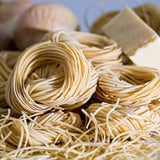Yes, You Should Switch to Whole-Wheat Pasta - Here's Why
 Get the Full StoryThe whole wheat vs. white flour discussion has been going on for a while, and the most health-conscious among us are now in the habit of avoiding white bread products like the plague. Epidemiologist Mark Pereira, PhD, confirms that whole-wheat flour has its benefits, explaining that " whole wheat is bulkier in the gut, more satiating, and thus likely more conducive to appetite and weight control." But is that all there is to whole wheat? It prevents us from overeating? Is whole-wheat pasta truly a better option than traditional pasta, or do we prefer it because we've been trained to regard darker wheat products as healthier?
Get the Full StoryThe whole wheat vs. white flour discussion has been going on for a while, and the most health-conscious among us are now in the habit of avoiding white bread products like the plague. Epidemiologist Mark Pereira, PhD, confirms that whole-wheat flour has its benefits, explaining that " whole wheat is bulkier in the gut, more satiating, and thus likely more conducive to appetite and weight control." But is that all there is to whole wheat? It prevents us from overeating? Is whole-wheat pasta truly a better option than traditional pasta, or do we prefer it because we've been trained to regard darker wheat products as healthier?Understanding Wheat
There are three parts to a wheat grain: bran, germ, and endosperm. The bran is the outer layer and is full of important antioxidants, B vitamins, and fiber. The germ is the sprouting portion of the seed and contains B vitamins, protein, minerals, and healthy fats. The endosperm is the largest part of the grain, made up mostly of starches, carbohydrates, and protein, with minimal minerals and vitamins.
Whole wheat is called "whole" because it includes all three parts of wheat. Alternatively, white flour has been more heavily refined and loses everything aside from the endosperm. In plain terms, whole wheat keeps the parts of the plant with important nutrients, and white flour only has the least nutritious portion.
Nutritional Value of Whole Wheat
When comparing nutritional facts side by side, whole and white flour products don't look too different. Both options are equal in protein, and the calorie and fat differences aren't very drastic. But the fact is that whole wheats are much richer in vitamin E, many major B vitamins, fiber, and antioxidants, all of which are better for you in the long run. And keep in mind that both carbs and sugar turn to energy that must be used or it will be stored as fat, and whole wheats have less of both.
The Verdict
It is clear that whole wheat - and therefore whole-wheat pasta - is better for you. Just be careful when selecting whole-wheat products, as some advertising can use misleading terms. It must say "100 percent whole grains" or "100 percent whole-wheat flour," not just "whole wheat." Choose whole wheat whenever you can, but it's OK to indulge in regular pasta or bread in moderation if you get a craving.
Share: